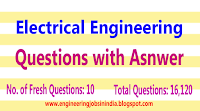Question No. 1. Electric resistance seam welding uses __________ electrodes.
(A) Pointed
(B) Disc.
(C) Flat
(D) Domed
Ans: B
Question No. 2. Spring constant in force-voltage analogy is analogous to
(a) capacitance
(b) reciprocal of capacitance
(c) current
(d) resistance
Ans: b
Question No. 3. The frequency and time domain are related through which of the following?
(a) Laplace Transform and Fourier Integral
(b) Laplace Transform
(c) Fourier Integral
(d) Either (b) or (c)
Ans: a
Question No. 4. When the initial conditions of a system are specified to be zero it implies that the
system is
(a) at rest without any energy stored in it
(b) working normally with reference input
(c) working normally with zero reference input
(d) at rest but stores energy
Ans: d
Question No. 5. The power of a n-phase circuit can be measured by using a minimum of
(a) (n - 1) wattmeter elements
(b) n wattmeter elements
(c) (n + 1) wattmeter elements
(d) 2n wattmeter elements
Ans: a
Question No. 6. As compared to shunt and compound DC motors, the series DC motor will have the
highest torque because of its comparatively ____________ at the start.
(A) Lower armature resistance. (B) Stronger series field.
(C) Fewer series turns. (D) Larger armature current.
Ans: D
Question No. 7. The transfer function is applicable to which of the following ?
(a) Linear and time-in variant systems
(b) Linear and time-variant systems
(c) Linear systems
(d) Non-linear systems
(e) None of the above
Ans: a
Question No. 8. The rotor power output of a 3-phase induction motor is 15 KW and corresponding slip
is 4%. The rotor copper loss will be
(A) 600 W. (B) 625 W
(C) 650 W (D) 700 W
Ans: B
Question No. 9. Zero initial condition for a system means
(a) input reference signal is zero
(b) zero stored energy
(c) ne initial movement of moving parts
(d) system is at rest and no energy is stored in any of its components
Ans: d
(A) Pointed
(B) Disc.
(C) Flat
(D) Domed
Ans: B
Question No. 2. Spring constant in force-voltage analogy is analogous to
(a) capacitance
(b) reciprocal of capacitance
(c) current
(d) resistance
Ans: b
Question No. 3. The frequency and time domain are related through which of the following?
(a) Laplace Transform and Fourier Integral
(b) Laplace Transform
(c) Fourier Integral
(d) Either (b) or (c)
Ans: a
Question No. 4. When the initial conditions of a system are specified to be zero it implies that the
system is
(a) at rest without any energy stored in it
(b) working normally with reference input
(c) working normally with zero reference input
(d) at rest but stores energy
Ans: d
Question No. 5. The power of a n-phase circuit can be measured by using a minimum of
(a) (n - 1) wattmeter elements
(b) n wattmeter elements
(c) (n + 1) wattmeter elements
(d) 2n wattmeter elements
Ans: a
Question No. 6. As compared to shunt and compound DC motors, the series DC motor will have the
highest torque because of its comparatively ____________ at the start.
(A) Lower armature resistance. (B) Stronger series field.
(C) Fewer series turns. (D) Larger armature current.
Ans: D
Question No. 7. The transfer function is applicable to which of the following ?
(a) Linear and time-in variant systems
(b) Linear and time-variant systems
(c) Linear systems
(d) Non-linear systems
(e) None of the above
Ans: a
Question No. 8. The rotor power output of a 3-phase induction motor is 15 KW and corresponding slip
is 4%. The rotor copper loss will be
(A) 600 W. (B) 625 W
(C) 650 W (D) 700 W
Ans: B
Question No. 9. Zero initial condition for a system means
(a) input reference signal is zero
(b) zero stored energy
(c) ne initial movement of moving parts
(d) system is at rest and no energy is stored in any of its components
Ans: d
Question No. 10. The maximum power for a given excitation in a synchronous motor is developed
when the power angle is equal to
(A) 0o
(B) 45o
(C) 60o
(D) 90o
Ans: A
when the power angle is equal to
(A) 0o
(B) 45o
(C) 60o
(D) 90o
Ans: A

Comments
Post a Comment